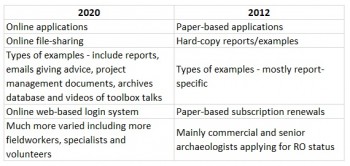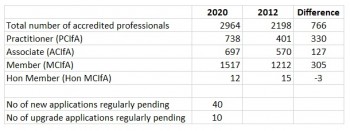
I joined CIfA in 2012 as the Membership Services Coordinator (MSC) who dealt with applications for individual accreditation, helping new and upgrading applicants with the process and supporting nine Area and Special Interest Groups.
I was promoted to Senior MSC in 2017 and I now manage the whole application process from helping people to apply to assessing Practitioner applications and looking at how to improve the member experience with CIfA. I support the Senior Management Team’s work by reviewing regulations, advising on processes and giving presentations about how to apply and CIfA’s work.
In my seven years working here I have seen many changes as CIfA has grown, not just with the number of staff we now have (6 to 16) but with the membership too and how many more people are engaging with CIfA and taking the opportunity to get involved and give something back to their profession.
I have made improvements to streamline the application process and noticed changes in the enquiries we receive, which I would like to share with you.
Process changes

In 2012, applications were made on paper documents along with hard copy publications. We used a simple database and corresponded by email and post with rather lengthy information about subscriptions and the Standards and guidance. Plus, the Application guide was rather extensive too (16 pages).
I streamlined this process as much as possible, initially shortening the Application guide (9 pages), using more email correspondence and accepting documents on a CD or USB stick. Now we send all correspondence electronically and use file-sharing systems for larger documents, which members of the Validation committee can view securely prior to the meetings; this saves a lot of time that was taken up with reading reports/examples of work thoroughly during the meeting.
In 2018, we introduced a new database with the online application facility, which allows applicants to apply online more easily and upload their documents in one place, plus this reduces the processing time so is more efficient. We are now working to improve this further by continuing to review the process, making information more accessible and ensuring you (our members) are aware of the work we (CIfA) are doing and can join in to make a difference.
Table 1: Application and subscription comparison 2012 with 2020

Common queries
Many enquiries used to be about the reasons why people should become a member of CIfA, but when we became Chartered in 2014, these changed to ask what level to apply for and about eligibility to apply with their experience or overseas experience.
I think this is because we have made a lot of effort to increase our communications with our accredited professionals and Registered Organisations, and we know from your feedback that you are telling your colleagues about being professionally accredited, how useful it is and how proud you are of the achievement.
“That is fantastic news!” “Thanks, I’m really ‘digging’ the news!”
“Thank you…I look forward to maintaining myself commensurate with practitioner grade”
“That is wonderful news... I look forward to being part of the organisation”
Application trends post-charter (2014)
- Total number of professionally accredited individuals has grown by 38%
- The average number of applications reviewed at each Validation meeting has increased by 30% (24 to +30)
- MCIfA accreditation increased by 19%.
Reasons for this include the potential for Chartered individuals and ensuring those that can demonstrate MCIfA see how they can apply, for example Project Officers and specialists.
- ACIfA accreditation increased by 26%.
Ensuring those who are no longer early-career archaeologists upgrade appropriately and providing support to enable them to do this.
- PCIfA accreditation increased by 95%.
Provided alternative route when CITB revoked the CSCS Health and Safety (CROW) cards. Ensuring those that have applied to use their accreditation for a card understand the Institute’s work, why it is important to be part of their professional Institute and get involved to support the future of the profession.
If you are not professionally accredited yet you can learn more and see if you are ready to apply here www.archaeologists.net/join/individual or email me (lianne.birney@archaeologists.net) and I will be happy to help - remember it is not a test but peer review of your experience and skills by a committee of existing members (who have been peer reviewed themselves). If you read all the guidance first and set aside a specific time to complete the application, you should be fine.
Table 2: Accredited professionals and application statistics


